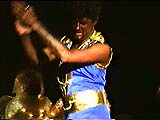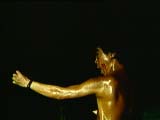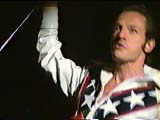David Leslie & Glass Eye Pix Presents
IMPACT ADDICT / press
IMPACT ADDICT videos | the tapes | bios | notes | press



C. Carr, THE VILLAGE VOICE, December 6, 1988
reprinted in ON EDGE: Performance at the End of the Twentieth Century
(Carr, Wesleyan/New England, 1993)The guy dressed like Julie Andrews was gonna fall from five stories up. Five! I panic as he wrapped himself around a fake tree near the roof of P.S. 122 wearing that ridiculous SOUND OF MUSIC dress, because the stage down in the courtyard was awfully small, and the cushion was really small, and there, pressed up against a fiberglass rock in the front row with a horde of screaming thrill seekers behind me, I calculate the arc-of-a-diver geometry, and ... He'd fall on me! He'd die! I'd die?
Well, I thought I'd rush ahead to the Good Part there, because David Leslie's deconstructed re-creations of heroic moments in media always go right to the Good Part, with just enough buildup to crank hearts into throats where we want 'em. Because nothing else really matters. We know the heroes. We know the plots. Just give us the Good Parts--when the theme music kicks in and Rocky jogs through Philly, Popeye squeezes that spinach can, and we know what's going down next. The highlight footage.
Leslie calls himself an "impact addict," but his work is more than daredevilry. Media gives birth to each stunt and to media each stunt returns. Larry Fessenden does the videos--typically, footage of a Leslie act intercut with slam-bang clips from Bruce Lee, Batman, the usual. Last week's event also began with a video, Leslie explaining how much he learned from the movies. More from BAMBI and PINOCCHIO than the church, he said. "The Disney thing...I believed in that as real knowledge." Over clips from ROCKY, THE WIZARD OF OZ, BORN FREE, he spoke of the movies giving him something to aspire to.
I heard derisive laughter in the crowd as we watched Sentimentality's Greatest Hits--those legs pounding the beach in CHARIOTS OF FIRE, for example. These were the people he wanted to emulate, Leslie told us, and these people came with a soundtrack. He was not being ironic. He would climb every mountain, and was about to risk his life to do it.
In his first stunt in 1986, Leslie propelled a little rocket off a 40-foot ramp on Broome street, supposedly to fly over a pile of 1000 watermelons and land in a net. Supposedly. He was running inside the rocket--the Flintstones version of Evel Knievel--so naturally he crashed. Later he said that the moment he left the ramp had been the most exciting of his life, the thing he'd been born to do. On Chinese New Year 1987, he wore a tiger suit fashioned out of 10,000 firecrackers, which exploded to reveal a rabbit suit underneath. In May 1987, he jumped from two stories up onto a steel plate in the courtyard of Café Bustelo, swathed in bubble wrap and white Christmas-tree lights. In June 1987, he went three-rounds on the Staten Island Ferry with Olympic-silver medalist Riddick Bowe (who declined to knock Leslie out though the artist had asked him to). Then, in October 1987, he donned the bubble wrap once more for a Franklin Furnace benefit, dropped through the roof of a martial arts school set, and had the members kick-slam him around the stage.
Now he was going to "retire," he said in his commercial for this "final act of excess and abandon"--because hype is inseparable from such an act--Leslie promised that like a boxer going out for his last fight, he'd "pull out a little something extra." For days he'd been installing cliffs, trees, and a plastic waterfall up the side of P.S. 122. Atop one cliff sat a billboard for Exterminator Chili. Like network television, his events and videos have sponsors. "I attempt to bounce male media's message off a funhouse mirror," Leslie says at the beginning of THE ROCKET MOVIE. Yet the message obviously captured his imagination. He sees it manipulate him but can't resist. "You don't want to be in a wreck and have somebody get hurt, but you wouldn't mind a little fender bender just to get that jolt," he says on another video, over clips from JAWS, RAGING BULL, the usual violence. "In the movies it's just depicted pain, beautiful image."
I think of J. G. Ballard, whose characters read primordial messages in the technology that surrounds them, whose "heroes" crack through the veneer of official reality with the aid of some violent act. In Ballard's world, images are more real than real life. Someone in CRASH collects footage of automobile collisions and dreams of dying in one himself--an act finally so real that he won't be able to watch the replay.
Leslie's work is a pure response to growing up in hyperreality, where we respond to images with our most powerful emotions. This creates a crisis of the real, a crisis of authenticity related to a crisis of the body, to needing what artist/writer Mary Kelly has called "the authenticating imprint of pain."
This makes Leslie's work poignant to me, even and maybe especially when it's a bit silly, as the final stunt was. Silly, earnest, and spectacularly exciting. Four people in bubble wrap and Christmas lights danced first--the warm up act. Leslie's heroes--Evel Knievel, Bruce Lee, and James Brown--hopped onstage for cameos. And then who should appear but Maria Von Trapp (Lucy Sexton), who disappeared behind a "rock" at the first strain of "Climb Every Mountain." Moments later the impact addict emerged in von Trapp clothing, like the stunt artist who comes in to take the hit for the star.
Leslie struggled up the cliffs as the song soared, his boots cracking into the fiberglass as he strained, heaving himself up, knocking off part of a rock, jumping a chasm, working without a net. Four stories up, he began to climb that last tree. The music changed to a stately rendition of "How Do You Solve a Problem Like Maria," and suddenly three nuns were standing below him on the fire escape, two with giant red axes. "Maria's not an asset to the abbey," the chorus warbled as the nuns chopped.
He fell with no grace. Thunked into the cushion, and just barely, it seemed. It had happened too fast to be visible to these naked eyes.
Now he belongs to the videotape.
IMPACT ADDICT VIDEOS | the tapes | bios | notes | press